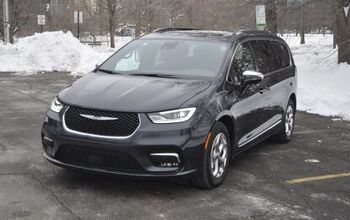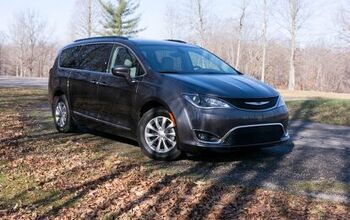Review: Last Call: Chrysler Pacifica
In the autumn of 2003, DaimlerChrysler introduced their first co-developed product: a “segment buster” called the Chrysler Pacifica. According to the official spin, the Pacifica married a minivan’s utility with an SUV’s machismo. In reality, the Pacifica was a six-seat station wagon on stilts, closest in concept to Audi’s slow-selling Allroad Quattro. While the Allroad pulled a Hasselhoff (more popular in Germany than its intended market), the Pacifica was born under a bad sign, raised with great expectations and expired stateside without fanfare or corporate hand-wringing. RIP Pacifica or good riddance to bad rubbish?
In many ways, the Pacifica was neither fish nor foul, starting with the proportions. It was taller than a car but lower than most SUVs. It had an exceptionally wide body and stretched nearly as long as Chrysler’s Town and Country minivan. But is still looked like what it was: a big-assed station wagon.
Chrysler designers used clever styling tricks to hide its heft. For example, the body sported multiple crease marks, near the window line, and again near the rocker panel. Like vertical stripes on clothing, the lines make the overall design seem longer and leaner. From the rear end, the Pacifica’s quarter panels taper dramatically inward from the rear wheels, thereby creating a thinner look. And the use of black molding on the roof give the vehicle the appearance of a sleek profile. The result was extremely color sensitive; dressed in white, you expected to see Captain Ahab pinned to the roof.
In keeping with Motown traditions, the first Pacificas hit dealer showrooms fully-loaded: all wheel-drive, load-leveling suspension, leather upholstery, heated first and second-row seats, sunroof, power liftgate, navigation (beautifully situated directly in front of the driver), dual zone climate control, DVD entertainment system and Sirius satellite radio. While the car’s upscale pretensions were obvious from the git-go, potential customers couldn’t see the price point. Initial Pacificas cost north of $35K. Even worse, the CUV’s build quality didn’t match the model’s “near luxury” aspirations. In-dash rattles, plastic panels that fell off, unpainted gas caps—the Pacifica (along with the new Crossfire Sports Car) was ground zero for dreams of Mercedes quality combined with Chrysler style.
Speaking of which, the Pacifica’s interior packaging sucked. The first two rows were spacious enough for four occupants, but the third row was suitable only for small, nimble, unloved children. When deployed, row three also left very little room for cargo, although it did fold flat when not in use. The Chrysler Pacifica posed the same question that the CUV genre still asks today: what IS the point? While modern CUVs answer with SUV-lite styling, the Pacifica looked like what it was: an expensive, big-assed station wagon.
Early Pacificas featured a mediocre engine (250hp 3.5-liter V6) and gear-challenged (four speed) transmission in a price bracket known for potent and refined powertrains. Thanks to the DaimlerChrysler’s vehicle’s heft and the ancient autobox, the Pacifica was both slow AND thirsty. The EPA rated its fuel economy at a less than desirable 15/20 mpg.
For the 2005 model year, Chrysler rectified the pricing problem (claiming it was their plan all along). The LX trim came equipped as a five-seater. In fact, the vehicle was thoroughly de-contented, including some very questionable seat materials, which undermined any chance of upmarket cachet. And did nothing much for sales.
DaimlerChrysler had a real dog on their hands. Not only did the vehicle fail to sell well, the company lost money on every one. The Pacifica sat on a modified minivan platform, but it didn’t share any interior furnishings with any other Chrysler, Dodge or Jeep product. The window switches, power seat controls (a nod to Daimler), audio and video entertainment options, seats, center console and the instrument panel weren’t interchangeable with any other vehicle.
Adding insult to injury, the Pacifica quickly developed a reputation for horrendous reliability. Straight out of the box, early models suffered from engine problems, transmission woes and the aforementioned quality control issues. Reflecting the analysis paralysis and cultural warfare bedeviling Auburn Hills, Chrysler failed to handle the Pacifica’s defects with speed or decisiveness. While some of early problems were eventually ironed-out, electrical gremlins plagued the Pacifica throughout its entire production cycle.
In sum, the Pacifica was one of the worst new car introductions in Chrysler’s history, with little or no advanced notice, hardly any pre-production publicity, and very little dealer training.
Since the Pacifica’s introduction, the CUV genre has exploded. Buyers looking for crossovers can choose from a wide range of vehicles that look like SUVs, burn gas like SUVs, won’t go off-road or tow like SUVs, and can’t carry more than five adults in comfort. But none of them—not one—looks like a bloated station wagon. There are brand new 2008 Pacificas sitting on ChryslerFiat dealers’ lots. Which tells you just about everything you need to know about the late, not-great Chrysler Pacifica.
More by Jim Brennan
Latest Car Reviews
Read moreLatest Product Reviews
Read moreRecent Comments
- Funky D The problem is not exclusively the cost of the vehicle. The problem is that there are too few use cases for BEVs that couldn't be done by a plug-in hybrid, with the latter having the ability to do long-range trips without requiring lengthy recharging and being better able to function in really cold climates.In our particular case, a plug-in hybrid would run in all electric mode for the vast majority of the miles we would drive on a regular basis. It would also charge faster and the battery replacement should be less expensive than its BEV counterpart.So the answer for me is a polite, but firm NO.
- 3SpeedAutomatic 2012 Ford Escape V6 FWD at 147k miles:Just went thru a heavy maintenance cycle: full brake job with rotors and drums, replace top & bottom radiator hoses, radiator flush, transmission flush, replace valve cover gaskets (still leaks oil, but not as bad as before), & fan belt. Also, #4 fuel injector locked up. About $4.5k spread over 19 months. Sole means of transportation, so don't mind spending the money for reliability. Was going to replace prior to the above maintenance cycle, but COVID screwed up the market ( $4k markup over sticker including $400 for nitrogen in the tires), so bit the bullet. Now serious about replacing, but waiting for used and/or new car prices to fall a bit more. Have my eye on a particular SUV. Last I checked, had a $2.5k discount with great interest rate (better than my CU) for financing. Will keep on driving Escape as long as A/C works. 🚗🚗🚗
- Rna65689660 For such a flat surface, why not get smoke tint, Rtint or Rvynil. Starts at $8. I used to use a company called Lamin-x, but I think they are gone. Has held up great.
- Cprescott A cheaper golf cart will not make me more inclined to screw up my life. I can go 500 plus miles on a tank of gas with my 2016 ICE car that is paid off. I get two weeks out of a tank that takes from start to finish less than 10 minutes to refill. At no point with golf cart technology as we know it can they match what my ICE vehicle can do. Hell no. Absolutely never.
- Cprescott People do silly things to their cars.


































Comments
Join the conversation
It's an old thread by I feel the need to reply to the haters. .. Bought a Pacifica because of the size, weight, and safety for my wife to learn to drive, and since our kids would be in it at the same time. I'm a professional driver with well over 500,000 miles (lost track around then) and have seen and I'll admit, done, lots of dangerous driving. Car has super comfortable ride. Seats are far apart as the body width provides a lot of space. Vehicle is super easy to get in/out as seats are at rump height. Great handling especially considering the bulk. (Regular car is/has always been a performance driver with well over 300hp and suspension mods) Tried to show her what to do when the ass end slides around in fresh wet snow. I could not lose control. I tried. Hard. Had it sideways with steering at full lock controlling it perfectly with the throttle. AWD version with no traction control. It was amazing. I quickly bought another to drive for my job up north in the heavy winters. Rear seats have plenty of room. Commentors to the contrary haven't figured out that front AND CENTER seats slide. Simply slide the centers forward and my 80!year old 6 foot one father says he's comfortable. And he'd complain believe me. At 150,000 miles it's getting a bit over 22mpg (10.5L/100km)on the highway (3.5L-4 speed). Yes it drops in the city (around 16L/100km). Weighs 5000 pounds with two adults and small children (I scaled it). If you get terrible fuel economy your foot is too heavy or you need repairs. Power is surprisingly good. It's is perfectly fine around town. Gets up and goes to join traffic. Just not so good at highway speeds where gearing can't make up for the small engine matched to high mass. I imagine the 4.0L 6 speed would be an improvement. Though it hides it's bulk well, yes, it is a fat ass station wagon. And I'd buy a new one if I could. Not the mini van version now out for 2017. Reliable? 240,000 km and runs and shifts perfectly. Wife's has 200k and is not holding up as well but it has a trailer hitch and has had a rough life with poor maintenance and at least two new drivers. Still running well, just not perfect. Nothing to complain about with these cars.
I completely agree with Dodgeman69. It's been a great car for me! I bought my 2004 Pacifica in 2005. It was a fleet car that had all of it's maintenance records. While it was the same price as a base model at the dealer, this one had the all wheel drive, DVD player, leather, sunroof and dolby digital surround sound that still blows most cars away and it was standard for the trim level. I had done quite a bit of shopping and it's the same Mercedes Frame, similar quality with cheaper insides. For me the 5 star crash rating, side curtain airbags and stability were big selling points. Here's the thing - after owning it 11 years old, this 12 year old car has only needed the notable maintenance of replacing the battery like clockwork every three years. It is sturdy. The doors are thick, the seats have girth and while it's heavy, there's good reason for it. I feel nervous in cars with flimsy doors. Now looking around I am hard pressed to find a replacement car with a DVD player, sunroof, captains chairs in the second row which are extremely comfortable for adult passengers AND there is NO IN CLUSTER NAVIGATION SYSTEM. I can't tell you how great it is to have the navigation in front of me. It's so easy to navigate AND you don't get the backseat drivers that comment on the route.... because they don't see it! All in all this car has been great for me. Living in California it has eaten gas and when gas was $5 a gallon it wasn't pleasant but that never outweighed the comfort, safety and enjoyment in this car. Say what you will but I love it's wide rear. It's comfortable without being a mini van and I can not find anything comparable!! It has 133,000 miles on it and I am milking it to the end as there is no suitable replacement!!!! ** Insult to injury - the 2016 Pacifica it a mini van... ouch.